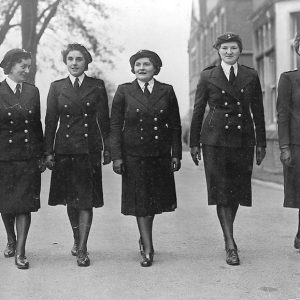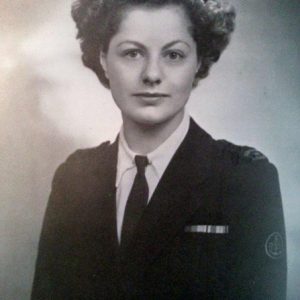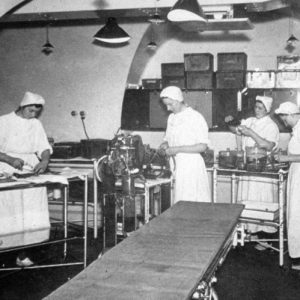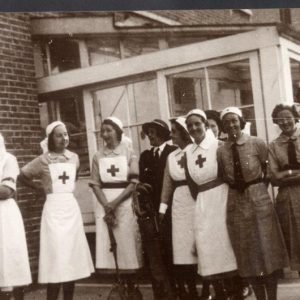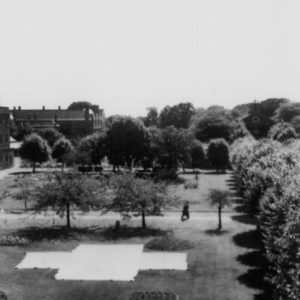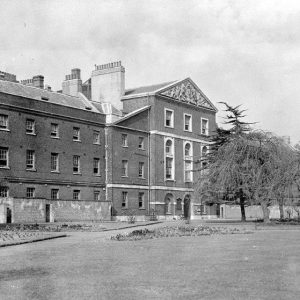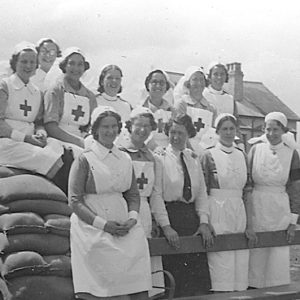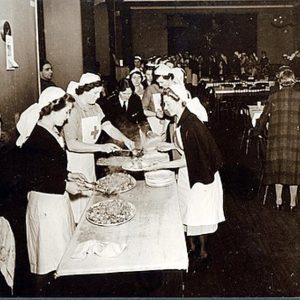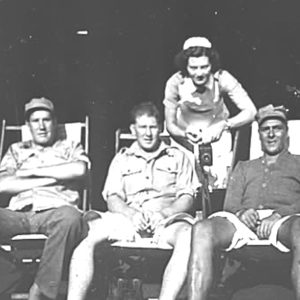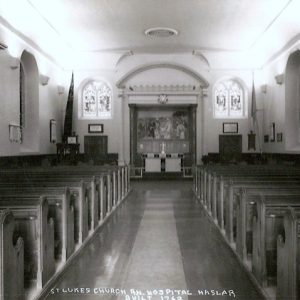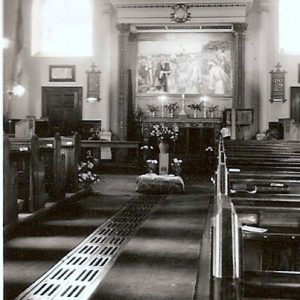Haslar's War - VE DAY
On Friday May 8th 2015 we celebrate the 70th Anniversary of VE Day Victory in Europe as our part of the Celebration and overview of Haslar’s part in WWII.
At the outbreak of WWII in September1939 the Royal Naval Hospital Haslar had stood and served the Royal Navy for 186 years and already taken its rightful place in the history of Great Britain. Through the 5 and half years of WWII Haslar’s staff were once again to be tested in caring for the sick and injured of war as it had on many occasions through the previous centuries, the patients were all treated the same be they friend, or foe from Trafalgar, Crimea through to WWI.
Tuesday 8th May 1945 VE Day was a normal working day at Haslar, patients were to be cared for on busy wards and in departments with staff in the cellar operating theatres carrying on as normal preparing for operations and even making tea from the boiling water from a spare steriliser, and eating NAAFI Biscuits between operations. The change meant no ‘Black out’ at night and the transfer of able patients to the cellars air raid shelters. Throughout the war those incapable of being moved especially with fractures and on traction remained in the wards to brave the raids but there were no record of injuries, or damage to wards.
Helen Long VAD nurse who worked in theatres describes in her book ‘Change into Uniform’ her time in underground theatres, there were 2 operating theatres but with 3 operating tables in each theatre and each table staffed by a surgical team, Surgeon, anaesthetist, and nursing assistants both VAD and SBA.’s. Helen describes dark corridors and stairs to save electricity and staff could only use the lift if they accompanied a patient and there was the ever present smell of Gas Gangrene in the air something that all VAD’s who worked in the theatre’s mentioned when questioned and the smell arose with many gangrenous limbs being stored because staff were too busy transferring patients to and fro and the disposal of affected limbs was dealt with once the pressure of work had subsided. VAD’s state that the Commandant VAD’s Miss I M Wastell when time permitted sent her girls up for some fresh sea air and as the war drew to a close.
Miss Phyllis Pearson VAD who worked in Theatres recalls that my most vivid memory is of a severely wounded Canadian Soldier. Just before he was to go into theatre he muttered as I passed him “Be an angel and get me a drink” as he couldn’t have anything by mouth I wrung out gauze swab and held it to his lips. He gave a sigh, “You’re an angel!” Those were his last words as he did not survive surgery.
To reach theatre we had to go down the staircase in the centre block and walk through dimly lit cellars. One day our first case was an amputation of a gangrenous leg. Whilst having a coffee break before the next case the Surgeon Commander asked if I was alright. “Yes thank you I replied”. He pursued the question again and I finally said “Well if you must know as I was coming through the cellars I passed three dead mice” and I promptly burst into tears!
When I came of duty I showered and slept for 4 hours and went to the galley and there were strawberries and being the season these were a welcome treat. However the smells of ether and gangrene in our clothes stayed with me and since that day I have never been able to eat a strawberry. Even seeing them on roadside stalls these days brings home the smell of the theatres back to me.
During the period of the war Haslar had dealt with some 83,446 patients, especially during the Dunkirk evacuation and D-Day when Haslar was in direct receipt of casualties from the Normandy beachheads. A Great number of RN Sick Berth Branch Probationers were trained at Haslar numbering 3248, the busiest year being 1941 when 827 were trained. It should be noted that 599 Royal Naval medical branch personnel including the Queen Alexandra’s Royal Naval Nursing Service (QARNNS) and Voluntary Aid detachment nurses (VAD’s) lost their lives during the war.
During the period of the war Haslar was mainly staffed by staff working alongside Nursing Sisters of the Queen Alexandra’s Royal Naval Nursing Service, Sick Berth staff and Voluntary aid Detachment, with members of the Medical Branch naval reserve all in support of Royal Naval Medical and Dental Officers, all supported by a civil service staff and alongside members of the Red Cross and St John’s.
Haslar’s war had been continuously busy and the hospital was touched by air raids and fires caused by incendiaries during air raids that were directed mainly at Portsmouth, especially the Dockyard and depots. It was always said that Haslar was spared thanks to the Water Tower being of use to the German Luftwaffe as a direction finder and a large Red Cross on a white background being placed on the lawn of the hospital quadrangle.
Staff tell of German prisoners of war requiring surgery screaming on their way to the operating theatres as they we told by their superiors prior to combat that if captured and requiring treatment that the enemy (us) would not give an anesthetic for surgery. Others were charming having been educated at either Oxford, or Cambridge and one German even attempted to strangle a VAD in the theatre grasping her throat and was rescued in time by 2 SBA’s.
Despite this during one air raid in 1941 the Haslar Museum received a direct hit and sadly many books and specimen’s from the founding of the museum in the 1830’s were lost and destroyed. In the spring of 1941 a direct hit on the medical store caused the loss of £80,000 worth of medical supplies. In 1941 through Haslar the first Royal Naval Blood Transfusion unit had been formed and in turn saved many lives.
Amongst the patients there was also a ships cat. In 1940 HMS Worchester whilst on Channel escort and patrol duties was damaged in a bomb attack and some 40 injured of the ship’s crew were transferred to Haslar for treatment. They all arrived at the Casualty reception and the last sailor was carrying Worchester the ship’s cat, he too was injured in the hind leg by a splinter and the admitting surgeon was told ‘That if Worchester was not treated then all the sailors would leave!’ Needless to say Worcester was admitted and he went to theatre (last) and had his leg treated and bandage. One of the VAD’s present describes a cat on a stretcher laying on his back leg in the air fully bandaged. He was admitted to the ward along with his shipmates and slept in an orange box. A few days later when the surgeon came to carry out his ward round Worcester accompanied the surgeon as he visited every one of his (the cat) ship mates. They were all discharged and Worcester was never heard of again.
In all Haslar undertook sterling work and care of the sick and injured, the underground operating theatres were the brain child of Surgeon Rear Admiral Cecil Wakely and in conjunction with a surgical team including Brigadier Elliot Cutler US Army and their combined planning was to save many lives especially during D-Day.
On VE night throughout Gosport, Portsmouth and Nationaly there were crowds everywhere, and people dancing round bonfires in the streets. That was of course, the night when the lights came on again all over the country, and ‘Blackout’ became a piece of history. The ships in Portsmouth harbour made the air victoriously hideous with their own peculiar kind of noise, and Haslar’s solitary chapel bell of St Luke’s rang madly – a combination which tightened my throat, filled my eyes, and made my knees turn to jelly, so much so that I had to sit down.
The chapel of St Luke’s, its windows aglow and wonderfully innocent now of blackout, was suddenly to become, by common consent, the focal point. The Quarter deck (Quadrangle) and all roads and footpaths leading to the little church began to fill with both patients and staff.
The service was short and to the point, as we roared our praise and thanksgiving until we all but raised the roof, ending with ‘O God, Our help in ages past’ and the National Anthem. As the men retrieve their fore-and aft and square rig caps, eyes were brimming over, and faces grey with late night fatigue and great weariness of soul smiled.
We all trooped out into the merciful darkness, to moved to speak – reluctant even, some of us, to leave this hallowed place, where it was easiest to keep contact with our dead. Tightly cocooned in my scarlet-lined cape, I lingered in the edge of the shrubbery until everyone had gone, and made a secret pact with myself to try to remember them all, as I walked – oh so slowly – the length of the now deserted Quarter-deck. The dead of Dunkirk, of that daring raid on St Nazaire; the men who now lay in the desert sands, the men of the Malta convoys and the men on the Normandy beaches.
Too many young faces by far came drifting through my mind’s eye, with their ‘Bull’s-eyes’, their bars of Canadian chocolate, their desert sores and typhoid, their desperate wounds and their pitiful stumps; the Germans screaming because they didn’t trust us, and our chaps suffering in silence because they did….
Haslar settled for the night once more and to 63 years more service until closure.
Eric C Birbeck MVO
Haslar Heritage Group May 2015.
Some extracts taken from ‘Change into Uniform’ by Helen Long nee (Vlasto)
With acknowledgement to Terence Dalton Ltd


